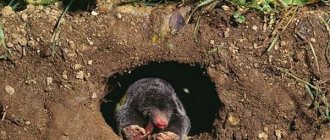- August 29, 2018
- Hunting
- Natali Michaelis
Mole hunting was once considered a fairly profitable activity. In the post-war years, particularly skilled hunters earned good money from this. The procurement offices accepted valuable skins for a good price. Plus, special coupons were given that made it possible to purchase various goods that were in great short supply at that time. However, today this type of hunting is gradually losing its popularity. Extraction of ordinary furs has become a very common and familiar activity. Most professional hunters believe that mole hunting is an extremely unprofitable and uninteresting activity. Is it really? Let's figure it out.
Features of mole hunting
Only a madman or someone who has no idea what this activity is like would go after this animal with a gun. It may seem to a novice hunter that hunting moles is a pointless and boring undertaking, but this is far from the case. If you taste all the delights of mole hunting just once, you will be captivated by this activity forever and will recommend it to all your friends and acquaintances. Perhaps if every skeptic tried this “strange” activity at least once, his opinion about mole catchers would change significantly.
Material dividends are not all that hunting animals can bring. From an emotional point of view, this type of hunting will allow a new look at nature even for those individuals who “see” it quite rarely. As a rule, moles begin to be hunted when the fields bloom with different colors, the smell of black currants is fragrant in the air, and young mushrooms begin to attract with their recognizable caps. This is the time when the aroma of freshly cut hay and meadowsweet is in the air.
However, despite all the above-mentioned romance, catching moles will not be easy. Like any other craft, this activity requires great dexterity and certain skills. It is worth knowing a lot about the biology of the animal, especially where exactly it lives.
Where do moles live?
In our country you can find 4 species of moles, but they hunt exclusively for the common mole. It is found throughout almost the entire territory of Russia - from the Don steppes to Arkhangelsk and from Transbaikalia to the western borders.
A mole can settle almost anywhere, but it prefers copses and forests. Small concentrations of this animal can be found in deciduous forests, but it has nothing to do in swampy areas. Moles are also often found in gardens and summer cottages. This pest loves to eat the young roots of bushes and garden crops, so people try to get rid of it in every possible way.
Planting repellent plants
This method of pest control is not as effective when compared with the use of various traps and baits. In addition, achieving results requires patience. However, the advantages include the opportunity to further improve the garden plot.
Among the “live” mole repellents are:
- Flower crops. These include marigolds, sage, calendula, chrysanthemum, irises, petunia, nasturtium, imperial hazel grouse, and Siberian scilla. It is recommended to plant them near the beds. It is also permissible to use infusions based on these plants.
- Garden crops such as potatoes, tomatoes, onions (including decorative ones), garlic, parsley, caraway seeds, dill. The effectiveness of planting crops is due to the high content of phytoncides in them, which have a repellent effect on moles.
- Insecticides of wild origin, some of which are harmful to humans. Among the safe ones are bird cherry, tobacco, spurge, burdock, mustard, and wormwood.
Krotolovka
Have you thought about how to get rid of moles in your garden? A standard mole trap is perfect for this purpose. Just a few decades ago they were quite primitive, but with the development of technology these devices have improved significantly, becoming even more effective. You can buy such a thing at most hardware stores that sell mousetraps. By the way, these two designs are quite similar in appearance and functionality, however, the mole trap is slightly larger in size.
Looking for a way to get rid of moles? Self-made traps can help you with this. To do this, you don’t have to resort to various tricks, and the material you can use is ordinary wire, which just needs to be twisted correctly. An analogue is a plastic trap, which is made from an ordinary bottle:
- First, we make the “body” of the pipe by cutting off the bottom and top of the bottle.
- The other two containers will require the tops to be cut off.
- The neck itself must also be cut off.
- In the remaining part we cut ribbons that are tightly driven into the pipe.
Such a mole trap is installed in holes through which animals move. Crawling through such a trap, the animal will easily push the ribbons apart, but will not be able to get back out.
Best time to hunt
You can start hunting moles as early as June 20, when the young animals have grown a little and begin to go hunting. The season ends in late autumn, when the first night frosts strike and the animal goes into hibernation. You can resume hunting immediately after snow falls, but most moles appear in the summer.
During the entire hunting season, you will need to place a large number of traps over a fairly large area, which must be divided into small areas. After the moles stop falling into traps, you can safely move to another place.
Common Mistakes
There is an opinion that a family of moles can be driven away from the site using products with a pungent odor placed in different places on the land. This is a mistake; small diggers sprinkle soil on the side where the bad smell comes from.
Another common mistake is using noise scares. Completely useless things. Moles happily settle near highways and railways.
Habits of moles in nature
A novice hunter should know all the behavioral features of moles in natural habitats, which can be used in hunting this animal. For example, a mole prefers to settle in rich soil, which is rich in insect larvae and earthworms, but at the same time tries to stay away from the lairs of large animals.
As practice shows, in our area moles are most often found in alder forests. If you decide to hunt in the fields, then you need to look for prey along the boundaries, but if in the forest, then near streams, as well as near paths and roads. The most important thing is to be able to distinguish the mole's feeding galleries from the deep-lying permanent entrances leading to the nests. You will definitely find several animals in the nesting chambers.
What to do with a caught animal?
A mole caught in a mole trap must be taken out of the area, carried away to a distance of about 1 km and released.
When freeing a captive, you need to be careful: moles have very sharp, albeit small, teeth, with which they can bite quite painfully (after all, moles are, first of all, predators). The epidemiological danger of moles has been poorly studied, and it is never possible to guarantee for sure that when an animal bites it it will not give a person some kind of bacterial “joy”.
The smartest thing to do is to take the mole out of the area directly in the mole trap, and at the place of release, simply open it and carefully shake the animal onto the ground. It is better to release the mole among thick grass or in the forest, where it has a better chance of remaining unnoticed by predators.
The release operation itself should be carried out immediately after discovery of the capture. As noted above, an extra few hours of hunger can be fatal for a mole.
Sources
- https://klopkan.ru/kroty/kak-poymat-krota-prostye-nadezhnye-i-effektivnye-sposoby/
- https://truehunter.ru/415893a-ohota-na-krota-izgotovlenie-lovushek-vyibor-primanki-sovetyi-opyitnyih-ohotnikov
- https://peschanoepans.ru/samostrel-krota-chertezh/
- https://krot911.ru/kroty/kak-izbavitsya-ot-krotov/kak-pojmat-krota-v-ogorode.html
- https://pxim.ru/krotolovka-svoimi-rukami/
- https://krot911.ru/kroty/kak-izbavitsya-ot-krotov/krotolovka-iz-plastikovyx-butylok-svoimi-rukami.html
- https://krot911.ru/kroty/kak-izbavitsya-ot-krotov/krotolovka-truba.html
Choosing a location for the trap
During the hot season, it is best to catch moles along ditches and streams, as well as on trails used by people and livestock for travel. In such places the soil is not so hot, so moles will be found here most often. During the rainy season, it is best to place mole traps directly on the surface, where the prey will crawl out of the water-filled holes.
Permanent and feeding passages are quite often located in close proximity to each other, forming a complex interweaving between them. In order to determine the type of burrows, do not hesitate to dig up the ground and examine them from the inside. If you find a feeding ground, then be sure that there will be a permanent passage nearby. Remember that setting traps in feeding holes is a waste of time.
Children's moves
During the period when the young begin to emerge from the nesting chambers, you can try to find the baby tunnels. In such places you can hunt for 5-6 days, and you will have to check the traps quite often - every 3-4 days. Such a find will allow you to catch a large number of animals in a short time. Trapped moles block the passage of other animals, which is why they have to take a detour. Here it won’t be difficult to catch them.
Remember that young animals are slightly different in size from adults, so it is necessary to make traps with the appropriate parameters. If the bottle or wire trap is too large, the animal can easily get out of it.
Fishing with a shovel
You can catch a mole with your own hands using a regular shovel. This method is the most accessible of all, but also the most labor-intensive. It is almost impossible to lure an underground pest out. A person needs a lot of patience and quick response.
The principle of operation is this: you need to keep watch and observe where the mole will appear next time. When the movement of the soil above the animal crawling underground becomes noticeable, at this moment you need to sharply stick a shovel behind the mole and pull it to the surface.
On a note!
When the animal is outside, it will be disoriented and will not be able to quickly disappear from sight. In such a helpless state, it is easy to place it in a bucket and take it away from the garden. It is recommended to release it in places with loose soil so that the animal can quickly hide underground.
Bait selection
Don’t know how to get rid of moles in your garden? Set up a mole trap in the area with some treats for the animal. It will be quite difficult to catch a mole in a trap without using some kind of bait. Experienced hunters recommend using ordinary earthworms for this purpose, since they are a favorite delicacy of moles, and getting them is not difficult. You just need to go out into the garden after the rain and dig the ground several times to a depth of about 20 centimeters. Worms try to settle in fertile and loose soil, so looking for them in fresh humus will be the most rational solution.
After that, we simply put a few worms in a plastic trap. They won’t be able to get out of there, but the smell will attract moles from a fairly large distance. The animal will probably want to feast on such prey and will fall into the trap itself.
You can also use some root vegetables as bait, such as chopped potatoes or carrots. You can purchase special oils that will attract moles from all over the area. For example, mole bait Bros. gives good results. This tool helps to lure moles from a fairly large distance. But experienced hunters still recommend doing it the old fashioned way and using worms as bait for moles in a trap.
Poisons
Unfortunately, many summer residents, who have resorted to both imaginable and unimaginable methods in the fight against moles, note that the most effective way of getting rid of them is the use of poisons. It is necessary to use poisons with extreme caution and is not recommended if the area is inhabited by domestic animals.
- There are special poisons developed to combat moles. They process earthworms, which are then placed in molehills and buried;
- The most cruel is the use of special smoke bombs, which produce a large amount of acrid smoke even underground, where a minimal amount of oxygen is supplied. The moles begin to run away from the smoke deeper into the tunnel, where they eventually suffocate from the suffocating gas.
Several important features
At the end of summer, it is recommended to install mole traps in large numbers and check them more often for the presence of prey, since at this time the animals begin to break up into pairs and actively reproduce. On one turn, you can catch two moles at once, and then move the traps with bait to another place.
It is worth noting that you should not install mole traps on every move found, since in this case you may simply not have enough traps. It is best to find a hole that has the smoothest and most compacted walls. We install several mole traps in it, and trample down the remaining passages. This will force the animals to use the path in which your traps are located.
To install mole traps, it is recommended to use areas that intersect with dense soil, for example, paths, roads, and so on. In these places, several animals use the passages at once, and not just one. Why is that? The fact is that in dry weather it is quite difficult for moles to break through compacted soil, and they somehow need to move from one place to another. That is why near the roads there are most of the discarded heaps of earth that other moles left here.
It is worth noting that if you decide to install a mole trap near a road where heavy vehicles and tractors often pass, then be prepared for the fact that the traps may slam shut due to vibrations. To prevent this situation, you need to add a little earth to the trigger. Or you can use ordinary plastic mole traps made from bottles, which do not have a complex mechanism.
In places where livestock graze, it is necessary to install 2-3 sticks or perches above the traps. This way, the animals will step over obstacles and the traps will remain intact. Also, do not forget to put mole bait, otherwise you will not get much results from the hunt.
Requirements for means for dissolving blockages
Any composition for cleaning sewers is subject to a certain set of requirements. If an industrially produced product does not comply with them, it will not be allowed for sale. There are no such strict restrictions for a homemade solution, but it is advisable not to ignore them. We will use these criteria when assessing the effectiveness of the formulations being analyzed.
Here are the requirements for means for dissolving blockages in sewer pipes:
- Efficiency. The ideal composition should remove blockages anywhere in the sewer system. Real formulations rarely achieve such effectiveness, having certain limits of applicability. Expanding the scope of application requires the introduction of potent substances into the composition, which is not always possible or justified.
- Health safety. It is advisable that the product does not burn the skin of the hands and mucous membranes. Unfortunately, this requirement directly contradicts efficiency. Therefore, it is recommended to wear protective gloves when using many recipes.
- Safety for the materials from which the pipes are made. This criterion sounds quite strict: the composition used should not destroy the cast iron and polymers from which the sewer system pipes are made.
- Availability and low price. The rarer the components are and the more expensive they are, the worse the product will meet this effectiveness criterion. It is for this indicator that homemade compositions often outperform gels, powders and solutions made in a factory.
- Easy to use. The composition should not require long exposure or use according to a complex algorithm. In addition, an ideal product should “forgive errors” when used, i.e., remain effective even if the instructions are not strictly followed.
We recommend: How, with what and when is it better to lubricate car hinges
Having decided on the principle of operation of homemade pipe cleaning compounds and formulated criteria for assessing their effectiveness, let’s move on to analyzing methods of dealing with blockages that have stood the test of time.











